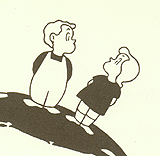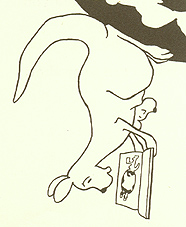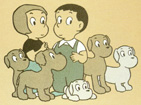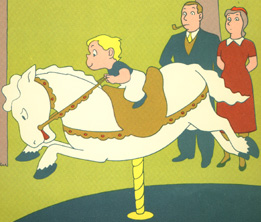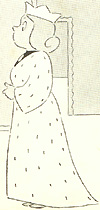Crockett Johnson’s Characters: Others from the 1950s and 1960s
Who’s Upside Down?
“In the picture, the kangaroo saw you, standing around where you live and not doing anything very much at the moment, and, halfway around the world, there was she.” You appear in both the geography book the kangaroo is reading and in the main text of Who’s Upside Down? Sometimes you respond to the kangaroo and other times you notice other illustrations, but you never speak.
Since “the kangaroo couldn’t read, even very short words,” she feels upside down and, when she feels upside down, is shown upside down. In response to this feeling, her little kangaroo steps back to take a look and tells her, “You look all right to me, ma.” Like Ellen’s lion, the little kangaroo is the practical member of the duo, suggesting that they turn the book around.
Terrible, Terrifying Toby
A puppy who thinks and acts, well, very like a puppy. At first wary of what he encounters, he barks and frightens animals and — he thinks — a milk truck away. Afterwards, he barks, triumphantly, “What a terrible and terrifying thing I am!” However, when he barks at his own reflection….
Time for Spring
Discouraged by the late snowfall, Irene decides to make “a very little snowman” because she had “very little interest left in things that had to do with winter.” When he comes to life, she grows concerned that winter will never end. She reluctantly participates in his winter games and, though she doesn’t wish for his demise, does wish for spring to come.
Irene’s snowman bears more than a passing resemblance to Mr. O’Malley in both body-shape and attitude. His ideas for winter fun are much more fun for him than for Irene (she carries the sled up the hill, then he sleds down on it). His comment that “Spring won’t come, while I’m here” worries her, but when she tries to refute him, he says, “Spring, no snowman” and “Snowman, no spring.” She agrees that the “first part’s true,” then he adds “And the last part follows.”
The Blue Ribbon Puppies
When one of the children decides that a particular puppy is, for example, “too tall” to receive the “best puppy” ribbon, the puppy looks at the child. The child then promptly has a change of heart (as you can see, these are very cute puppies.)
Merry Go Round
On the merry go round, the boy rides, round and around. It is as if a camera were attached at center of the ride, its lens fixed on the boy: with each turn of the page, he remains at the center, but the background shifts, recording his motion. Beneath the pictures, in all capitals, with minimal punctuation, the text proceeds, each page offering a line of almost exactly the same length:
PAST THE GLASS HOUSE WITH FLOWERS IN IT
PAST THE STATUE OF A HORSE AND A GENERAL
PAST HIS MOTHER AND FATHER, WHO WAITED
“ISN’T IT EVER GOING TO STOP?” THEY SIGHED
Like the sentence, the ride never ends, and the boy (referred to only as “he”) turns round for as long as the reader keeps turning the pages.
The Frowning Prince
Accustomed to the smiling (or at least benign) faces of Crockett Johnson’s child characters, it comes as a surprise to see a child looking as cross as this one. The prince seems to enjoy the power he gains by refusing to stop frowning, but — at times — one wonders if the frown has taken on a life of its own and if, perhaps, he really does have an immovable frown.
“I want that frown removed from your face immediately,” he said, pointing his jeweled scepter at the prince. “It is a royal command.”
“It is an immovable frown,” said the prince.
“It is not,” said the king.
“Is so,” said the prince.
The king’s struggle to stop his son from frowning often seems like a battle of wills. After watching the king, we know where the prince gets his stubborn streak.
The queen, on the other hand, pays little attention to the prince’s frowning. Of the frown, she remarks, “It will go away,” pats the prince’s head, and does not respond to the prince’s challenge, “How can it go away? . . . Nothing can make it go away. It’s immovable.” She seems to understand implicitly that to argue with the prince will only encourage him. But she patiently endures her husband’s contest with his son.
Will Spring Be Early? Or Will Spring Be Late?
A very conscientious, good-natured groundhog. Before rushing off to spread the news, he pauses: “I must be certain there is no sun. I must make sure I have no shadow.” When he listens and smells for the sun, a passing truck interferes with his senses and, seeing an artificial flower dropped by the truck, he thinks it real and jumps to the wrong conclusion
We Wonder What Will Walter Be? When He Grows Up
Although his episodic quest for what to become recalls The Little Prince (1943), Walter is not as profound as Antoine de Saint-Exupery’s characters. But, clad in grey trousers and a black t-shirt, he could pass for a young existentialist, learning to accept the burdens of his freedom. Irrespective of his dark attire, Walter is not somber; he is instead thoughtful, marked by that inquisitive spirit which characterizes nearly all of Johnson’s fictional creations.
A gentle lion who takes Walter’s question seriously, he acts with good intentions, and offers Walter the most sage advice of all: “Whatever you decide, be sure to make your decision bravely, without fear. Think boldly!”
The Emperor’s Gifts
Like the Lion in We Wonder What Will Walter Be?, the Emperor seems to have arrived from a parable. He is young, wise, and able to gauge the needs of the six kings who visit him. He speaks very little, saying only “Thank you” for each gift and adding that each “is good to have.” A good listener, he rules well and with an understanding beyond his years
Gordy and the Pirate and the Circus Ringmaster and the Knight and the Major League Manager and the Western Marshal and the Astronaut; and a Remarkable Achievement
The last of Johnson’s small children with big imaginations, Gordy differs from his predecessors in one very significant aspect. While Harold and Ellen dream themselves into many adventures, Gordy works to keep his adventurous desires in check. Like the Emperor (in The Emperor’s Gifts), Gordy meets one distinct character after another. But the Emperor must think to solve the problems of those he meets; Gordy, on the other hand, must resist others’ problems in order to successfully go “straight home.”

